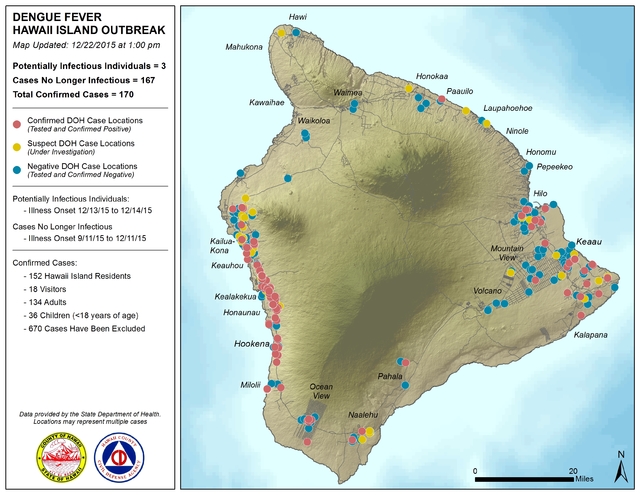KAILUA-KONA — Hawaii County Civil Defense closed Milolii Beach Park in South Kona, the second West Hawaii park to shut down in the battle against dengue fever. ADVERTISING KAILUA-KONA — Hawaii County Civil Defense closed Milolii Beach Park in South
KAILUA-KONA — Hawaii County Civil Defense closed Milolii Beach Park in South Kona, the second West Hawaii park to shut down in the battle against dengue fever.
A cluster of new cases and heavy mosquito activity prompted the state Department of Health to recommend the closure while crews spray insecticide to knock down mosquito populations in the park.
Kaialii Kahele, director of Paa Pono Milolii, said four of his cousins have come down with the illness in the past month. One 10-year-old boy and another man fell ill about three weeks ago. Two other men in their 20s and 30s were sickened last week, he said.
The boy is doing well but one of the men went to the emergency room twice.
“He had uncontrollable high fever and was real sick,” Kahele said. “Everyone is recovering but it is definitely starting to scare. Milolii is a small place.”
The tight-knit fishing community of about 300 depends on catchment water. Many of the holding tanks aren’t properly covered and are prime breeding grounds unless the water is properly treated, Kahele said.
DOH and county crews went house to house in the neighborhood on Wednesday, inspecting tanks and looking for standing water that could harbor mosquitoes. A holiday candlelight vigil is normally held at a church near the park, which acts as a town center for the community, and the park’s closure makes it unclear where the vigil will be held, Kahele said.
DOH entomologists and vector staff have been working at the park and surrounding residences, said state epidemiologist Sarah Park. The Milolii cases point out that the public shouldn’t let its guard down, she said.
“It’s going to be a constant challenge,” Park said. “It’s not just for the Big Island, it’s statewide. We all need to think about this, especially with the holiday and traveling.
“Like the CDC says, we’re never going to get rid of all of the mosquitoes,” Park added. “We are trying to knock down the populations to a low enough level that we can break the breeding cycle.”
Following a brief lull in cases, dengue picked up again on Wednesday, with a half dozen new cases bringing the total to 176 since the beginning of the outbreak. Of those cases, 158 are residents and 18 are visitors.
Eight of the cases are recent enough that the infected persons could still transmit the virus to mosquitoes, which in turn could spread the disease further.
Another hotspot for dengue, Hookena Beach Park, remains closed, and access to both South Kona parks is limited to local residents. There is no estimate on when either facility will reopen.
The northern half of the island has remained relatively free of the disease up until recently. However, a suspected case in Hawi is being investigated and several suspected cases and one confirmed case have also appeared on the Hamakua Coast.
The DOH and Civil Defense continue to closely watch Puna, but are encouraged that there have been no new recent cases there following a campaign to spread information and get rid of standing water, Park said. The Kona Coast from Keauhou to Milolii continues to be the greatest area of concern.
Following recommendations from the Centers For Disease Control and Prevention, the DOH has stepped up its treatments designed to reduce mosquitoes in the larval stage, Park said. But the message to the public hasn’t changed. Protecting yourself from mosquitoes is a good idea not just in the current outbreak, but as a training for future outbreaks of dengue and other tropical diseases, Park said.
Symptoms of dengue include a high fever, intense headache and body aches and rash on the arms. Residents are urged to continue to “Fight the Bite” by avoiding areas of heavy mosquitoes, wearing repellent and long clothes and getting rid of standing water around their homes.
“Many of us are traveling during the holiday,” Park said. “If you go some place and are ill within two weeks of your return, go to your doctor and make sure he is aware of where you went during your vacation.”



